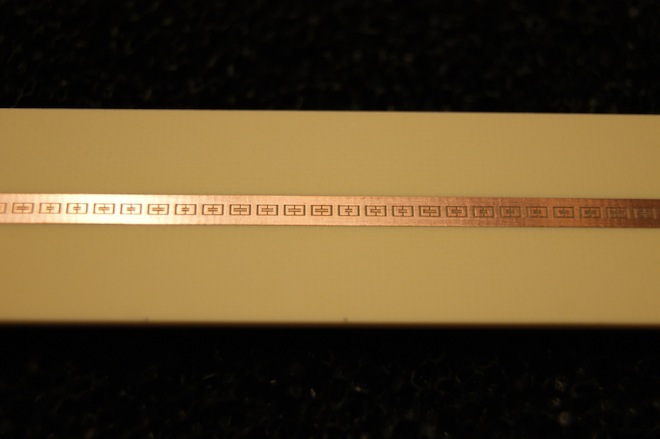January 17, 2013
In the recently published "Metamaterial Apertures for Computational Imaging" Duke University researchers discovered by leveraging metamaterials and compressive imaging, a low-profile aperture capable of microwave imaging without lenses, moving parts, or phase shifters can be demonstrated. Their discovery is discussed further with Nadia Drake from WIRED below.
By Nadia Drake
WIRED
"A small, microwave-detecting camera that can see through solid materials in real time has been developed. Soon, the device could be adapted and used in law enforcement and security where, among other uses, its inventors envision airport scanners that screen passengers for weapons or explosives as they walk by.
The camera features a one-dimensional aperture made from a copper-based metamaterial. Fashioned from plastics or metals, metamaterials behave in ways that ordinary materials naturally do not. Some can cloak objects. Others can reveal them. Here, scientists used the copper-based metamaterial as an aperture for microwaves, the telecommunications workhorses that populate the longer end of the electromagnetic spectrum. By connecting the aperture to an image-reconstructing computer, the researchers can capture information from a scene in real time, with no moving parts.
'They’ve made a very clever way of gathering the relevant information in the scene,' said physicist Willie Padilla of Boston College, who was not part of the camera-building team. 'And to do it in a novel way with electromagnetic metamaterials — that’s a key advance. There are no moving parts.'
Detecting microwaves produces a very different view of the world than looking at it normally.
'You can see through certain materials that you can’t see through with optical light – such as clothing or wood. But at the same time, you can still see plastics, metal, skin,' said graduate student John Hunt of Duke University, co-author of a description of the device published today in Science. 'Dust and fog and rain, things that might be in the air are essentially invisible at these frequencies.'
The metamaterial aperture shuttles microwaves reflected from a scene to a computer, which then reconstructs the scene using mathematical algorithms the team developed. The whole process takes just 100 milliseconds and requires no moving parts and no image compression – meaning that the camera could capture moving scenes in near real time, and without losing details.
Traditional cameras rely on lenses that guide light to detectors comprising millions of pixels. Human eyes use a similarly organized system: a light-focusing lens, plus light- and color-detecting rods and cones arranged on the retina. Because optical wavelengths are short, a detector array can fit in the back of an eye or a tiny camera.
Not so for microwaves, which can be one meter long.
These longer wavelengths have traditionally required bigger detectors that are slow, expensive to construct, and require continuous reorientation to capture targets. One of the most familiar examples is the much-maligned airport body scanner, which requires travelers to step inside and strike a pose while a detector-containing bar whizzes around, collecting images that are scrutinized by TSA agents.

Image is of "close-up of the one-dimensional metamaterial aperture" credit: John Hunt/Duke University ECE
The camera Hunt helped design is different. The metamaterial aperature is only 40 centimeters long and it doesn’t move. It’s a circuit-board-like structure consisting of two copper plates separated by a piece of plastic. One of the plates is etched with repeating boxy structures, units about 2 millimeters long that permit different lengths of microwaves to pass through. Scanning the scene at various microwave frequencies allows the computer to capture all the information necessary to reproduce a scene.
'With that, and some pretty interesting math, we’re able to make a picture of the scene that’s in front of us,' Hunt said.
In the current study, researchers aimed the camera at a room that had been muffled by microwave-absorbing foams on the walls and ceiling – and then studded with bright metal objects — “Little balls, basically,” Hunt said.
After turning on a nearby microwave transmitter, the team watched as the metamaterial aperture shunted microwaves bounced around by the metallic objects to the computer, which created a two-dimensional reconstruction of the scene.
'To my knowledge, this is probably the first example of metamaterials and compressive imaging in the same paper,' said Kevin Kelly, an electrical engineering professor at Rice University who helped develop the first single-pixel camera.
To recreate a scene in three dimensions the team will need to build a two-dimensional aperture. That’s not far off, Hunt said. Then, the applications for such technology will be broad, he said, especially because the device is inexpensive to build, light, and portable.
'As a replacement to an airport scanner — you can just walk right past it,' Hunt said. 'No more long lines.' And that’s just one idea. Adapting the system differently could yield a quicker baggage scanner. Embedding a microwave-detecting camera in the front of self-driving cars could help vehicles navigate scene-obscuring snow, rain, and fog. Embedding one in the wing of an airplane with one would eliminate the need for space-consuming radar imagers. Designing a hand-held, metal-detecting device could produce the ultimate stud-finder.
Lining the front of a police officer’s vest could help the officer detect concealed weapons — guns and knives — and distinguish them from cellphones.
'It will be exceptionally cheap,' Padilla said. 'You can indeed simply adhere it to a wall and it can perform imaging.'
##
The full article by Nadia Drake can also be found here.
